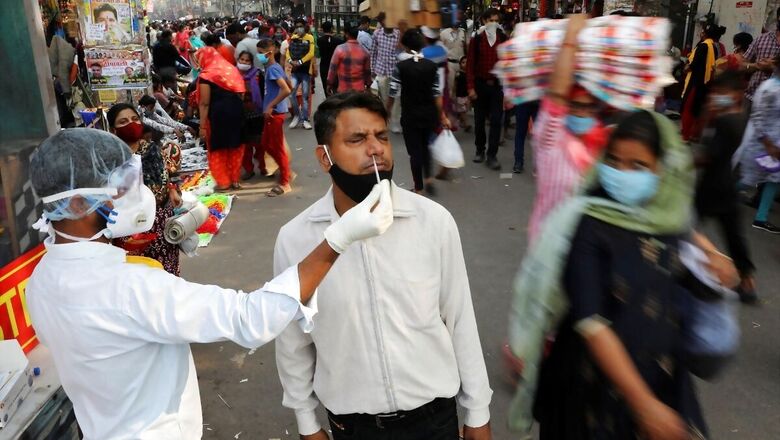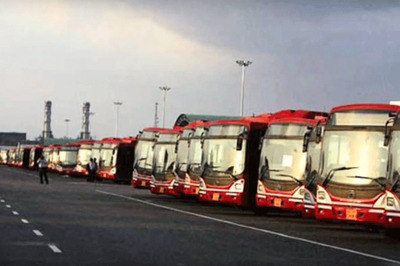
views
As of November 28, India has 6,731 Coronavirus cases per million population. In comparison, the United States has 40,000 cases, the United Kingdom has 23,361, France has 33,424, Brazil has 29,129 and Italy has 25,456. On an average these worst-affected countries have about 4-5 times the number of cases than reported in India.
Talking about the number of deaths per million population. India witnessed 98 deaths per million population till November 28, while the US reported 813, Brazil- 805, France- 780, Spain- 955, UK- 846 and Italy- 888. The whopping number of deaths in these countries are on an average about 8-9 times more than India.
From the peak of almost 97,894 daily cases in mid-September, the cases went down to 43,174 cases on 26 November, showing a downward trend.
Nearly 10 days after China notified the world about the deadly Wuhan virus, India started screening international passengers from January 17, among the first countries in the world to do so. On January 30, the first Covid-19 case was reported in India, following which aggressive containment and screening measures were instituted then and there.
On the other end of the spectrum, India was among the first to introduce Rapid Antigen Tests along with RT-PCR tests. India was criticised initially for this strategy but later the World Health Organisation (WHO) itself has adopted this model.
It was in March first week itself that Prime Minister Narendra Modi announced that he would not join any Holi milan event since the scientific advice was to stay away from social gatherings. It was among the earliest examples among world leaders to send a message to the country to maintain social distancing.
By April, protective masks were made mandatory to contain the spread of the virus with PM Modi himself wearing masks in public. Meanwhile, the WHO waited till June before recommending it to the world over.
Early Lockdown to Contain Exponential Spread
When PM Modi called for a complete lockdown on March 24, India had just about 500 cases. The growth rate of new cases had increased from 10.9% to 19.6% in just one week and the doubling time was just over three days. The government’s decision of the timely lockdown was first amongst several other affected countries, if the decision to impose lockdown was delayed, India would have risked going down the European or the US trajectory.
The Centre utilized the period of lockdown to create 15,362 dedicated Covid-19 health facilities, about 15.40 lakh isolation beds, 2.70 lakh oxygen supported beds and 78,000 ICU beds. It also delivered 32,400 ventilators to government hospitals across the country. However, in the last 70 years these government-run hospitals possessed only 12,000 ventilators. The incumbent government also provided 3.70 crore N95 Masks and 1.60 crore PPEs to state governments, when other developed countries were facing a massive dearth of PPE kits.
PM Modi’s Leadership – A Crucial Ingredient
As PM Modi led the way in refraining from social gatherings in early March, this conveyed the seriousness of the situation. In the upcoming days, he addressed the nation and came out with a unique ‘Jan Bhagidari initiative‘ called ‘Janata Curfew’. He exhorted the people to observe a countrywide lockdown of one day and show the world how India could unite to fight the pandemic.
Actively participating in an emphatic way, the one-day janata curfew prepared the nation for an upcoming lockdown. Prime minister then announced a nationwide lockdown from March 24 and gave the message of ‘Jaan Hai Toh Jahaan Hai’. he guided people to wear protective masks, clean hands regularly and refrain stepping out of home.
During the initial phase of lockdown, PM Modi called for people to light lamps and show solidarity with frontline workers, especially healthcare professionals in a unique way.
Months later, before the ‘Unlock’ phase, PM Modi addressed the nation and guided them with the philosophy of ‘Jaan Bhi Jahaan Bhi’. With a well-coordinated lockdown phase, India made a transition into the ‘unlock’ phase in a systematic manner.
Throughout these phases, PM Modi’s personal leadership assured every Indian that they were in safe hands that was following sound scientific advice and putting the objective of saving lives above everything else.
This is the reason for today’s situation where India’s infections per million and deaths per million are both much lower than many developed countries.
Help from the government throughout the pandemic
While the nation was reeling under rising cases and widespread infection, there was also an urgent need to fight poverty. There was a need to ensure that the disruption doesn’t become distress for the poor and immediately, the incumbent government swung into action.
Through the Rs 1.70 lakh crore Pradhan Mantri Garib Kalyan Package (PMGKP), the government announced free food grains and cash payment to women, poor senior citizens, and farmers.
The numbers achieved by this programme are mind-boggling and could have made some world records in itself. Around 42 crore poor people received financial assistance of Rs 68,820 crore. Rs 17,891 crore was transferred under PM-KISAN scheme to almost 9 crore farmers.
Nearly Rs 31,000 crore was transferred to 20 crore women Jan Dhan account holders in 3 instalments. Rs 2,814.50 crore was transferred to about 2.81 crore old age persons, widows and disabled persons in 2 installments. 1.82 crore building & construction workers received financial support worth Rs 4,987.18 crore.
About 13 crore free Ujjwala gas cylinders were delivered to poor households. Under Garib Kalyan Anna Yojana, nearly 80 crore people received free food grains and pulses till November, month on month. And remember, wherever cash transfers were done, they went directly to the bank accounts of the beneficiaries – no leakages.
Pharmacy of the World
After witnessing the second peak, now PM Modi is personally accessing vaccine development in the country. He is on a three-city visit to review the vaccine development and manufacturing process. The first visit is scheduled for Zydus Biotech Park in Ahmedabad followed by Bharat Biotech, Hyderabad, and Serum Institute of India, Pune.
Two of these sites are where India is indigenously developing vaccines to fight Covid. India is not only leading the world in research for vaccines but will also be crucial for the world’s vaccine production.
On December 4, ambassadors of 100 countries are scheduled to visit Pune, they will visit Serum Institute of India and Gennova Biopharmaceuticals Limited.
Impact of the Unlock: Most High-Frequency Indicators Looking Up
India went into lockdown early and also unlocked the economy much earlier. The impact of this is seen in most high-frequency indicators seeing an uptick. Manufacturing Purchasing Managers’ Index (PMI) rose from 56.8 in September to 58.9 in October 2020, registering the highest figure in over a decade. PMI Services index also rose to 54.1 in October, ending the seven-month sequence of contraction, signaling improved market conditions.
Power consumption clocked double-digit YoY growth of 12.1 per cent in October and 4.5 per cent in the first 24 days of November, reflecting a post-recovery rebound and even in growth economic activity across all spheres – agriculture, industry, and services.
Passenger vehicle sales reported 2 per cent growth in October 2020, while total domestic sales of two-wheelers increased 16.8 per cent, auguring well for consumption demand.
Domestic tractor sales posted a 7 per cent YoY growth in October, auguring well for rural demand and signaling an early indicator of the transformation arising from agricultural reforms introduced under the Aatmanirbhar Bharat package.
E-way bills generated witnessed a double-digit YoY growth of 21.4 per cent in October, reaching an all-time high of 641 lakh, and 7 per cent in the first 23 days of November.
GST collections swelled to an eight-month high at ₹1.05 lakh crore in October – crossing ₹1 lakh crore after February, 2020 – registering a positive year on year growth of 10.2 percent.
Railway freight grew YoY at 15.4 per cent in October and 13.6 per cent in the first 10 days of November. Also, gross revenue from railway passenger bookings stood at ₹533.27 crore in the first ten days of November, reaching 8 per cent of October levels.
Cargo traffic volumes in October have reached 7 per cent of previous year levels, registering a 1.23 per cent YoY growth. Domestic aviation passengers increased from 2.8 lakh in May to 28.32 lakh in August and 39.43 lakh in September and 52.71 lakh in October. Under MGNREGA, 252.4 crore person days of work have been created during April to October of FY 2021 as against 159.7 crore person days in the corresponding period of previous year.
Economic Impact of the Pandemic
GDP for Q2 of FY20 contracted by (-) 7.5 per cent, much smaller when compared to the contraction of (-) 23.9 percent reported for Q1 of FY20.
Between these two quarters, already a huge improvement can be seen in private consumption expenditure. Agriculture reported a growth of 3.4% in Q2, the same as in Q1. Manufacturing has grown by 0.6% in Q2 as compared to a contraction of (-) 39.3% in Q1.
Read all the Latest News, Breaking News and Coronavirus News here




















Comments
0 comment